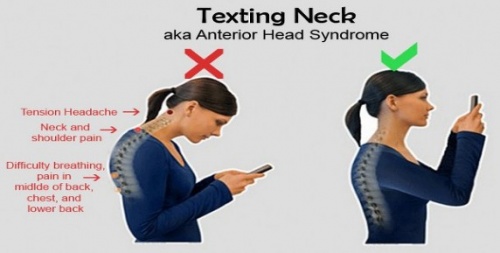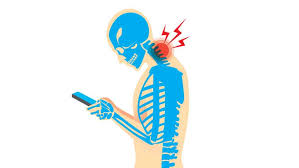The average person in the United states spends anywhere between 2-4 hours per day looking down at their phone. Add those hours up over the course of a year and you’re looking at 700-1400 hours! This modern-day phenomenon is widely known as “text neck”.
So, what exactly is “text neck” and what are these contemporary conveniences doing to our bodies?
The term “Tech Neck” was coined in order to address the impairments and injuries associated with this prolonged flexed neck position. This posture, along with rounded shoulders, can result in face, jaw, or skull pain, headaches, neck pain, shoulder pain, disc degeneration, and overall stiffness of our neck and shoulder muscles. Spending excessive time in dysfunctional postures such as this one, as well as lack of exercise, stretching, and postural stabilization can lead to increased flexion of our lower cervical vertebrae and the upper thoracic vertebra, increased “flattening” of our upper cervical vertebrae, and tightness in the muscles at the base of our skulls.
Symptoms of text neck:
- Headaches, due to tightness or tension in the muscles attaching to the skull (suboccipitals)
- Upper crossed syndrome- tightness of the upper trapezius, levator scapula, pectoralis major and minor along with weakness of the deep neck flexors, middle, and lower trapezius.
- Stiffness and or pain in the neck
- Possible disc compression or narrowing of the spine
- Changing of the structure and shape of the cervical or thoracic spine.
- Decreased lung capacity
A surgeon-led study that published in Surgical Technology International assessed what impact surgeons’ head and neck posture during surgery—a posture similar to that of smart-phone texters—has on their cervical spines. With each degree that our heads flex forward (as we stare at a screen below eye level), the strain on our spines dramatically increases. When an adult head (that weighs 10 to 12 pounds in the neutral position) tilts forward at 30 degrees, the weight seen by the spine climbs to a staggering 40 pounds, according to the study.
How prevalent of a problem is this?
According to the study, the average person spends 14 to 28 hours each week with their heads tilted over a laptop, smartphone or similar device. Over the course of a year, that adds up to 700 to 1400 hours of strain and stress on our spines. As a result, the number of people dealing with headaches, achy necks and shoulders and other associated pain has skyrocketed.
What to do to combat this issue?
Ergonomic work desks placed at the appropriate heights and angles can greatly reduce our tendency to adopt this maladaptive forward head posture as well using the correct number of pillows while sleeping.
Reducing time on our smart devices to less than 1 hour and taking breaks every 30 minutes while completing computer work or reading are great ways to reduce excessive time looking down. Performing exercises that lengthen commonly affected and shortened muscles such as our upper trapezius, neck muscles, and pectorals will help to alleviate tension and soreness in the head and neck. Finally, performing activities that reinforce proper postural alignment such as chin tucks and scapular stabilizer strengthening are key tools to improve upper quarter endurance and reduce forward head/rounded shoulder posture.
Over time, this type of poor posture can have a cumulative effect, leading to spine degeneration, pinched nerves and muscle strains. Scheduling an appointment with a physical therapist can help people learn how to interact with their devices without harming their spines. The PT will prescribe an at-home program that includes strategies and exercises that focus on preserving the spine and preventing long term damage.
Stay tuned for our video exercise series that will demonstrate a few easy techniques to improve your “text neck”.
For more information please contact Innovative Physical Therapy at 619-260-0750 to speak with one of our therapists today!
Research from: T oh SH, Coenen P, Howie EK, Straker LM. The associations of mobile touch screen device use with musculoskeletal symptoms and exposures: a systematic review. PLoS One 2017; 12(8): e0181220. Accessed 18 July 2019. Jump up↑ Sharan D, Mohandoss M, Ranganathan R, Jose J. Musculoskeletal disorders of upper extremities due to extensive usage of hand held devices. Annals of Ann Occup Environ Med. 2014; 26(22). Accessed 18 July 2019. Jump up↑ Kwon JW, Son SM, Lee NK. Changes in upper-extremity muscle activities due to head position in subjects with a forward head posture and rounded shoulders. J Phys Ther Sci. 2015. 27; 6:1739–1742. Accessed 18 July 2019. https://ppsapta.org/userfiles/File/APTA
